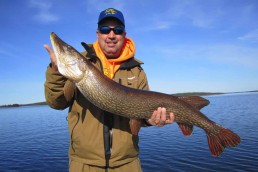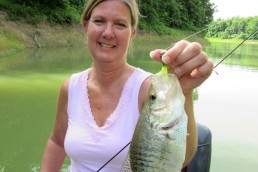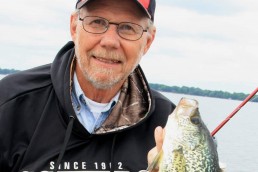Soft Plastics: Don’t Leave Home Without ‘Em
SHARE THIS POST
You better have a pile of plastics along.
Once there was this small cove tucked away in back of an island. It wasn’t much of a spot, but we were approaching it, chucking bucktails in search of a muskie or a pike, when Poppee snagged a tree. Obviously, we weren’t going to lose his lucky bucktail, so I pointed the trolling motor toward shore and a little cove. The trolling motor scraped the bottom, lodged up and “rocked.” The boat had stopped just short of the bucktail retrieval-grasp.
Poppee looked down and saw a muskie right next to a cabbage bed.
“Look at that fish—he’s a big one!”
It was over 40 inches and looking right at us. So I poked it with my rod tip and we named him “James.” We weren’t able to pursue him further at the time.
“We gotta come back for James, later today,” I said.
For the day we had popped a few walleyes, ate a shore lunch, watched eagles soar and had ended with 35 follows—just another typical day on Lake of the Woods.
But now it was time to get serious and catch James.
Poppee’s first cast did bring James to the boat. That fish followed that lucky black bucktail right to our vessel, nudging it with his nose and his mouth closed. He had then made a quick turn and went back to his cove. We went around the corner, made a few casts, caught a dinner-sized pike in the process, and then returned to seek James once again.
In the next 30 minutes, Poppee brought him back to the boat seven times. He had followed that black bucktail again, but never opened his mouth. One time James actually bumped the side of our boat with his nose. I reached into my walleye plastics bag and pulled out a white twister and stuck it on the back of Poppee’s lucky bucktail. This proved to be poison: four casts and no James. A chartreuse tail was also equally ignored.
I was told to put on the orange one, so I did.
On the next cast, here comes James—only this time he had his mouth open and he nipped that twister right off the bucktail. Poppee and I both looked at each other in astonishment. Then, a few seconds later, James rose up right in front of us like a submarine and burped up the orange twister tail, which then proceeded to float up to the surface.
“Let’s never come back to this spot, Poppee,” I said, exhausted.
Are you enjoying this post?
You can be among the first to get the latest info on where to go, what to use and how to use it!
We never did.
Another time we were up on a big pike fly-in and couldn’t even buy a fish. We were fishing shallow, clear water and you could see the pike lying belly-to-the-bottom like pike cordwood. They weren’t interested in any of the conventional weapons we were trying at the time: topwaters, bucktails and crankbaits. Poppee then pulled out a Black 1/4-ounce B-Fish-N H20 jig and put on a Black 5-inch K-Grub in the Smoke color. We knew it was the right choice because the guide we were with repositioned himself, got the fish cradle unraveled and laid his jaw spreaders and pliers out.
It was a pike frenzy after that.
The only problem was that there were only 12 K-Grubs in the bag within Poppee’s pocket.
What happens when you run out of minnows just as walleyes start biting? What happens when minnows are $10 a dozen and you’re sick of spending $100 a day and see most die in a bucket and turn into soup?
Again, you better have that pile of plastic along and ready to use.
Bob Gillispie brings a group of guys to Canada each spring. The quarry is trophy pike, but the backup plan is the lake trout and walleyes.
“A lot of these northern-pike trophy lakes go through cycles—one year the big pike lake has more trophy walleyes than pike,” Gillispie says. “It’s cyclical or due to the weather this time of year. I learned a long time ago that plastics added to baits will turn an average day into a memorable one.”
And with only a 75-pound weight allotment per man, we’ll adjust and just cut down on overpacking clothes and bulk up on the plastics.
A jig is still your most versatile lure in Canada, except for maybe a spoon. We’ll replace the treble hook on the spoon with a heavy single-gauge 7/0 swash hook and slide on a 5-inch K-Grub. It works through weeds, can be fished on top, down deep and even vertically jigged.
We’ll also bring a good supply of jigs. Color isn’t as important as the variety of weights. The plastic tails will add the color needed. The Moxi and the Pulse-R are our go-to jigs, while the K5 Grubs can go on the spoons. I’ve taken some giant fish on these two combinations even though I do bring a variety of bucktails, crankbaits and spinnerbaits. Still, it’s still the spoons and jigs that produce.
New this year, we’ve developed a jig for pike, lake trout and walleyes called the MasterFlash. It comes in four weights and six colors and has over 300 strands of holographic tinsel and a glitter paint job on the jig head. This jig has the flash and attraction big fish can’t resist.
So no matter where you are planning to head off to in Canada this summer, take if from an expert: don’t leave home without your plastics.
MWO
SHARE THIS POST
Did you enjoy this post?
You can be among the first to get the latest info on where to go, what to use and how to use it!
Walt Matan
Walt Matan has been a writer and television host for MidWest Outdoors for 30 years. An avid ice and open-water fisherman, he currently lives in the Quad Cities on the shores of the Mississippi River. He is the product developer and brand manager for Custom Jigs & Spins, B-Fish-N Tackle, and Rippin Lips Catfish Tackle. For more information visit customjigs.com.



